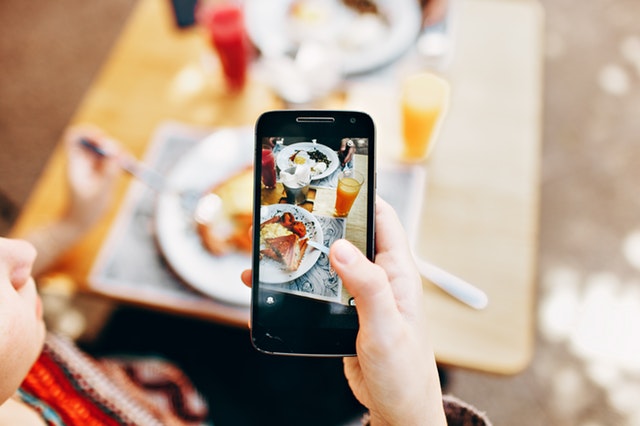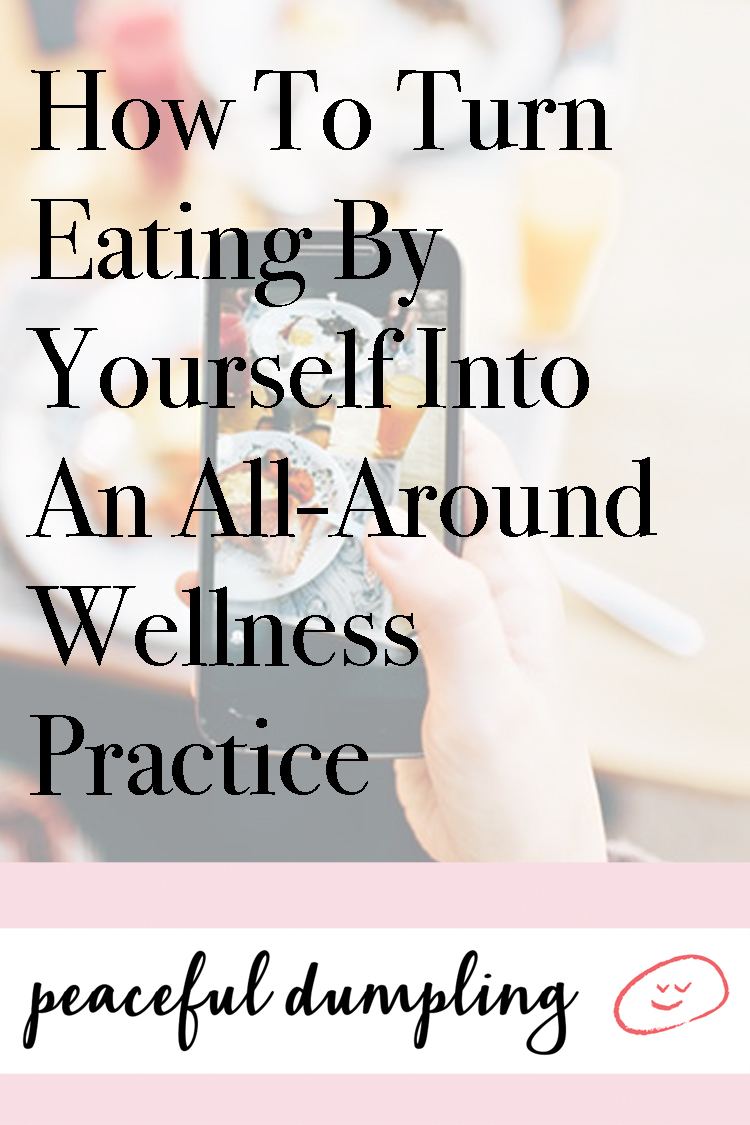
Is your phone hungrier than you are? Free yourself of the distractions that can block your digestion and learn to love your food in a new way.
Simon Sinek’s groundbreaking book about finding meaning in life and business, Start With Why, has a very loud refrain that any sensitive reader (ahem, yours truly) might say verges on excess by about halfway through. Still, it’s a compelling mantra that speaks volumes about his philosophy of achieving success only when there is a clear sense of purpose: “People don’t buy WHAT you do, they buy WHY you do it.” Apple isn’t the tech giant it is today because they make awesome computers—though that’s part of it; people say they’re “Mac people” because of the values that Apple instills into its awesome computers, like innovation and revolution.
Food offers an imperfect analogy for this idea. We at Peaceful Dumpling often emphasize how key it is to cook with and eat high-quality, organic, minimally processed foods because they’re more respectful of the earth, they preserve our resources, and they just taste better (and make us feel better, too). But a key part to feeling really great about what you eat goes beyond the food itself (Sinek’s “what”). How you eat, the mindset that you approach your table and plate with, can have an even greater impact on the way your body literally digests, in addition to your mood when you’re not eating.
Holistic lifestyle practices like Ayurveda have long prioritized the how of eating, explaining how a “sattvic” or peaceful state of mind and location will ensure a smoother digestive process. So-called “Mindful Eating” is not a new thing to the dieting and weight-loss community, but in our current age of meditation studios creeping up on every corner, and our ears being plugged in not with the latest Top 20 hit but brain-wave stimulating soundtracks, it has another greater significance. The classic meditation exercise of taking five minutes to eat a single raisin is proof that bringing more awareness to your every bite can have a huge impact on your overall sense of awareness and sensation—in other words, calmness. When we activate the rest and reset part of our brain (the parasympathetic nervous system) in this way, our digestive system can work properly; contrast that to what happens to our bodies during a fight or flight response (sympathetic nervous system), wherein all non-vital functions shut down (like digestion, hormone production, and cell turnover) so we can focus on getting out danger.
I don’t think any of you would need your arm twisted to be convinced that a more mindful approach to eating—meaning no work, no email, no Instagramming, and no sad-desk-salads eaten between clicks—would be better. Most of my favorite and tastiest meals had little to do with the food itself, but more because of how I ate them leisurely in an atmospheric restaurant with a close friend. That scenario is harder to replicate at home, though, when you’re sitting at a table for one. Personally, I find that staring at a wall while I mindfully chew each bite 32 times (the recommended amount—and yeah, it’s as much as it sounds!) is not quite as fun as, say, scrolling through Instagram or reading a glossy magazine during dinner.
And yet . . . when there’s a will there’s a way, so in my recent experiments with improving some chronic tummy troubles I’ve discovered a few ways to make my meals quieter in all respects—and my intestines couldn’t be happier for it.
- Close your eyes: Literally turn off the visual distractions of your eating experience and begin to tone your interoception muscles. The cousin of proprioception—knowing where your limbs are in space—interoception is about feeling the inner processes of your body. An interoceptive sensation might be the wave-like whoosh you can feel of your bodily fluids when you tune inward. When you eat without looking around you, the experience of the intake of that food takes precedence over everything else. You can obviously open your eyes to see what you’re eating, and taking in the color and texture of the food is itself a way to be mindful and appreciative of the nourishment it gives you. Having soothing artwork and colors in your eating space helps, too.
- Clear the table: My kitchen table doubles as a desk, so it’s usually piled with notebooks and mail and things that remind me of Work. Removing those cues has helped me separate the process of eating and working in the same way it’s recommended to not work on your computer in bed.

Having a clear and inviting atmosphere where you eat helps you get to mindfulness more easily.
- Gain perspective: Much of my own excuses for eating while doing other things is “I don’t have time to just eat!” Stepping back, though, the amount of time it takes me to eat a meal isn’t really all that long, usually around 20 minutes. If I can choose to do other alone-time activities, like going another 10 blocks on the long route to the subway for more fresh air, or meditating for 14 minutes in the morning, what’s another 20 if it makes my day and belly better? For me, the time I’m spent being “unproductive” while eating outweighs the suffering that comes after a rushed meal.
- Deep belly gratitude breaths: My family didn’t pray before meals, but the ritual of pausing to be grateful for the food before you and the people who made it deeply aligns now with my vegan values. I don’t do it as often as I should, but combining that pause with belly-softening exercises makes me grateful, too, for my own body’s ability to thrive on that food provided to me by others and the earth. Simply rest your hands on your belly below the navel, close your eyes, and take three full, long breaths that you can feel with your hands. When you open your eyes, I guarantee you’ll be calmer and perhaps even hungrier for what’s before you.
- Cook in singles: Most of my cooking is meal-prep style, meaning I make enough of a recipe to last me a long time. Often I find myself rushing to eat more so I can get to clean up all the leftovers and dishes. When I make a truly one-serving meal, though, that cloud isn’t hanging over me; it also gives more obvious portion control, because I know how much I have to eat at that moment, no more and no less. Although it takes more time to prep and cook individual meals, again those few minutes are worth it if I’m not bent over with cramps from poor digestion hours later.

What are you favorite mindful eating tricks? How have you established your mindful routine while eating by yourself? Share @peacefuldumpling #eatslow
Also by Jennifer: Guess What, Your Gut Affects Your Personality–& Other Facts About Your Insides
Related: Why Mindful Eating Is A Balm For Anyone Who’s Ever Battled Disordered Eating
Mindful Living: On Cooking as Meditation
Get more like this—Subscribe to our daily inspirational newsletter for exclusive content!
Photos: Pexels.com
